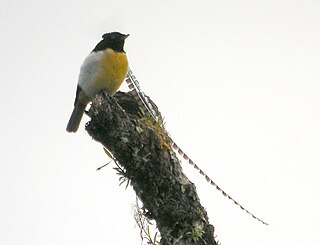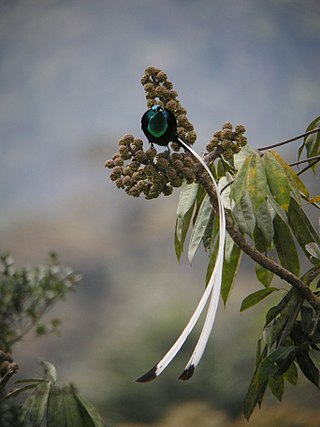
The birds-of-paradise are members of the family Paradisaeidae of the order Passeriformes. The majority of species are found in eastern Indonesia, Papua New Guinea, and eastern Australia. The family has 45 species in 17 genera. The members of this family are perhaps best known for the plumage of the males of the species, the majority of which are sexually dimorphic. The males of these species tend to have very long, elaborate feathers extending from the beak, wings, tail, or head. For the most part, they are confined to dense rainforest habitats. The diet of all species is dominated by fruit and to a lesser extent arthropods. The birds-of-paradise have a variety of breeding systems, ranging from monogamy to lek-type polygamy.

The blue bird-of-paradise is a large species of bird-of-paradise. It is the only species in the genus Paradisornis, but was previously included in the genus Paradisaea.

The Arfak astrapia is a species of astrapia, a group of birds found in the birds-of-paradise family Paradiseidae.

The King of Saxony bird-of-paradise is a bird in the bird-of-paradise family (Paradisaeidae). It is the only member of the genus Pteridophora. It is endemic to montane forest in New Guinea.

The ribbon-tailed astrapia, also known as Shaw Mayer's astrapia, is a species of bird-of-paradise.

Astrapia is a genus of birds-of-paradise. The genus contains five species, all endemic to New Guinea. The males have highly iridescent plumage and remarkably long tails. Females are duller and have shorter tails.

The black sicklebill is a large member of the birds of paradise family, Paradisaeidae. This species is found throughout most of central New Guinea and the Vogelkop region to the northwest in montane forests at altitudes from 1,800 to 2,150 m.

The magnificent bird-of-paradise is a species of bird-of-paradise. The magnificent bird-of-paradise is evaluated as Least Concern on the IUCN Red List of Threatened Species. They are listed in Appendix II of CITES.

The greater lophorina, formerly a subspecies of the superb bird-of-paradise, is a species of passerine bird in the bird-of-paradise family Paradisaeidae. It is found in the central and northeast montane regions of New Guinea.

Carola's parotia, also known as Queen Carola's six-wired bird-of-paradise or Queen Carola's parotia, is a species of bird-of-paradise.
The eastern parotia, also known as Helena's parotia, is a medium-sized passerine of the bird-of-paradise family, Paradisaeidae, endemic to mountain forests of the Bird's Tail Peninsula. It is approximately 27 cm long.

The Huon astrapia, also known as Rothschild's astrapia, Huon bird-of-paradise, or Lord Rothschild's bird-of-paradise, is a species of bird-of-paradise belonging to the genus Astrapia. Like most of its congeners, A. rothschildi is a rather elusive member of its genus and family.

Stephanie's astrapia, also known as Princess Stephanie's astrapia, is a species of bird-of-paradise of the family Paradisaeidae, native to the Bird's Tail Peninsula. This species was first described by Carl Hunstein in 1884.

The Splendid astrapia is a species of Astrapia of the birds-of-paradise family, Paradisaeidae, and one of the least known and most elusive of its family and genus.

The mountain kingfisher is a species of bird in the subfamily Halcyoninae in the family Alcedinidae. Adult males are 21–24 cm (8.3–9.4 in) long, and have a rufous head and underparts, greenish-blue upperparts, a dark blue tail, and black flight feathers. They also have dark neck patches and loral patches. Females have dark crowns and the neck patches join at the nape. It is similar to the yellow-billed kingfisher, but can be distinguished by its larger size and a proportionally larger bill, along with a dark ridge along its culmen.

The red satinbird, commonly known as antenna satinbird or crested cnemophilus and formerly known as the sickle-crested bird-of-paradise, is a subspecies of bird in the family Cnemophilidae. It was formerly placed in the bird-of-paradise family Paradisaeidae until genetic work proved it was unrelated to those birds. It is found in the Bird's Tail Peninsula, Papua New Guinea.

Elliot's bird of paradise is a bird in the family Paradisaeidae, first described by Edward Ward in 1873, but which was later proposed to be a hybrid rather than a “real” species, an identity since confirmed by DNA analysis.

The Central Range sub-alpine grasslands is a montane grasslands and shrublands ecoregion on the island of New Guinea. The ecoregion covers the highest-elevation portions of the New Guinea Highlands, which extend along the spine of the island. The high elevations support rare tropical sub-alpine and alpine habitats, including many endemic plants and animals.
















